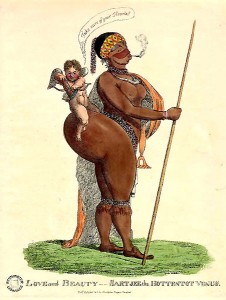The tradition of exhibiting people of color in Western societies has existed since the earliest encounters between Europeans and indigenous populations in the New World and in Africa. Indeed, on his return to Spain after his first voyage to the New World in 1492, Columbus brought several Arawaks to Queen Isabella’s court, where one of them remained on display for two years. Exhibiting non-white bodies as a popular practice reached its apogee in the nineteenth century in both Europe and in the United States when freak shows — the exhibition of native peoples for public entertainment in circuses, zoos, and museums — became fairly common. In the United States, in particular, the spectacle of “freaks,” “natives,” and “savages” became a profitable industry at this time, as epitomized in popular traveling shows like Buffalo Bill’s Wild West Show and Barnum and Bailey’s Circus. World Expositions were also popular for the display of native bodies. During the expositions “natives” performed various ceremonies, rites, dances, and otherwise went about their (supposed) daily routines (even though they were on the exposition grounds). In other words, cultural “others” were employed to perform their “cultural otherness” for an Anglo-American and European audience. Up to the mid-twentieth century displays of this sort continued. (See Essentialism)
Live exhibitions were not the only forms of human spectacle; often the dissected and embalmed remains of the “native” body, particularly the skulls, and sexual organs, were also publicly exhibited. Trophy heads, body parts, and other skeletal remains still reside in the collections of many Western museums, such as The British Museum and La Musée de l’Homme, France. As recently as 1997, a small natural history museum just outside of Barcelona finally removed a stuffed Bushman from its permanent display cases, only after sustained international pressure to do so. The incident strongly suggests that European fascination with exhibiting non-white bodies is not a phenomenon of the distant past.
Saarjite Baartman/ The Hottentot Venus
Saarjite Baartman, a young Khosian woman from Southern Africa whose body was the main attraction at public spectacles in both England and France for over five years, is perhaps the most infamous case of a Khosian body on display. Baartman, who became known as the Hottentot Venus, was brought to Europe from Cape Town in 1810 by an English ship’s surgeon who wished to publicly exhibit the woman’s steatopygia, her enlarged buttocks. Her physique, particularly her steatopygic appendage, became the object of popular fascination when Baartman was exhibited naked in a cage at Piccadilly, England. When abolitionists mobilized to put an end Baartman’s public display, she informed them that she participated in the spectacles of her own volition. She even shared in profits with her exhibitor.
The spectacle of Baartman’s body, however, continued even after her death at the age of twenty-six. Pseudo-scientists interested in investigating “primitive sexuality” dissected and cast her genitals in wax. Baartman, as far as we know, was the first person of Khosian-descent to be dismembered and displayed in this manner. Anatomist Georges Curvier presented Baartman’s dissected labia before the Academie Royale de Medecine, in order to allow them “to see the nature of the labia” (Gilman 235). Curvier and his contemporaries concluded that Baartman’s oversized primitive genitalia was physical proof of the African women’s “primitive sexual appetite.” Baartman’s genitalia continued to be exhibited at La Musée de l’Homme, the institution to which Curvier belonged, long after her death.

This introduction to the history of human displays of people of color demonstrates that cultural difference and “otherness” were visually observed on the “native” body, whether in live human exhibitions or in dissected body parts on public display. Both forms of spectacle often served to promote Western colonial domination by configuring non-white cultures as being in need of discipline, civilization, and industry. (See Orientalism, Myths of the Native, Third World and Third World Women)
Works Cited
- Gilman, Sander L. “Black Bodies, White Bodies: Toward an Iconography of Female Sexuality in Late Nineteenth-Century Art, Medicine, and Literature.” Race, Writing and Difference. Ed. Henry Louis Gates Jr. Chicago, 1986.
- Hinsley, Curtis. “The World as Marketplace: Commodification of the Exotic at the World’s Colombian Exposition, Chicago, 1893.” Exhibiting Cultures. Eds. Ivan Karp and Steven Lavine. Washington, DC: Smithsonian Institution Press, 1991.
- Ugwu, Catherine. Ed. Let’s Get It On: The Politics of Black Performance. London: Institute of Contemporary Arts, 1995.
- Wallace, Michelle. “Modernism, Postmodern and the Problem of the Visual in Afro-American Culture.” Out There: Marginalization and Contemporary Culture. Ed. Russell Ferguson. 39-50.
Author: Krista A. Thompson, Spring 1998
Last edited: October 2017